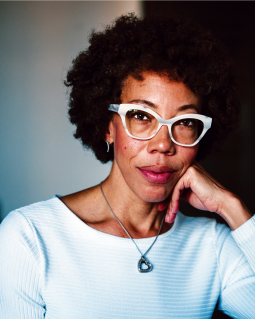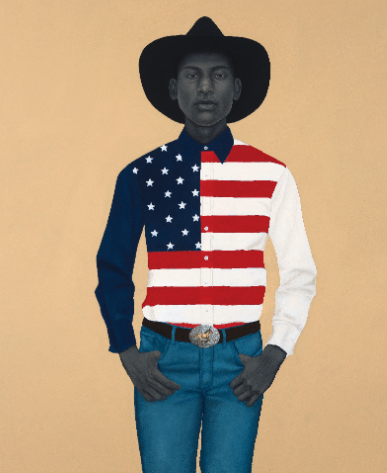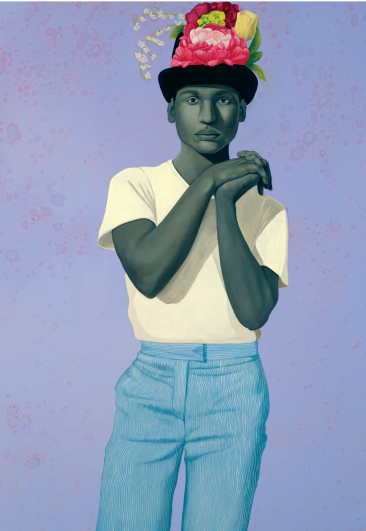Left: Amy Sherald, What’s different about Alice is that she has the most incisive way of telling the truth, 2017. Oil on canvas, 54 x 43" (137 x 109 cm). Right: Try on dreams until I find the one that fits me. They all fit me, 2017. Oil on canvas, 54 x 43" (137 x 109 cm). Images courtesy of the artist.
 Amy Sherald. Photo by Justin T. Gellerson.
Amy Sherald. Photo by Justin T. Gellerson.
Portrait of a First Lady
The national spotlight turned to Sherald when Michelle Obama selected her to paint her official portrait for the Smithsonian National Portrait Gallery. The painting was unveiled in February 2018, along with Barack Obama’s portrait painted by Kehinde Wiley, also an African American artist. Sherald is the first African American artist to paint an official first lady portrait. Of the Michelle Obama portrait, art critic Jerry Saltz wrote in Vulture that it depicted her as an “everyday queen of heaven: She is grand, elegant, gorgeous, but her jackrabbit-quick wit is right there. Set against a monochrome flat powder blue, the First Lady is a guiding star to another kind of glamour, a serious spirit whose sorrows were released, who spread warmth, respect, a sly sense of humor, and protectiveness. And a different idea of female power and beauty.”
The National Portrait Gallery announced a free giveaway of teaching posters for both the Michelle and Barack Obama portraits. Because of the more than 30,000 requests that have been received, submissions were suspended as of this writing. Check npg.si.edu/obama-poster-request-form in the Spring of 2019 about renewed availability.
 What’s precious inside of him does not care to be known by the mind in ways that diminish its presence (All American), 2017. Oil on canvas, 54 x 43" (137 x 109 cm). Image courtesy of the artist.
What’s precious inside of him does not care to be known by the mind in ways that diminish its presence (All American), 2017. Oil on canvas, 54 x 43" (137 x 109 cm). Image courtesy of the artist.
Interview
The 2019 NAEA National Convention, held in Boston this March, is honored to be hosting Sherald as a keynote speaker. Sherald graciously shared her thoughts with SchoolArts in anticipation of her appearance at NAEA:
SchoolArts: When did you first realize that art was what you were born to do?
Amy Sherald: Probably high school, but I knew I wanted to be an artist from a very young age. I don’t think you can really realize you were born to do something until you can look back and see how life has fallen into place. How you met all the right people, and you were at all the right places at the right time.
SA: What are some of the biggest influences on your work, including other artists, events, or things outside of the arts?
AS: My upbringing and my environment has had a great influence on my work. Movies like Big Fish, and pretty much every Wes Anderson movie made. The life and musical journey of John Coltrane. Photographers such as Gordon Parks, Vivían Maier, and Wayne Lawrence. Painters such as Rembrandt and Velázquez, and American painters such as Bo Bartlett.
SA: How do your portraits express what you perceive in your subjects?
AS: They express through their pose but also by what they are wearing. I think the greatest way is through their eyes. It’s them but essentially it’s the presence I see beyond their outward appearance. What qualifies them and is the impetus for me to approach them, no one else may see. It’s like spotting someone you do not know in a crowd, but for some reason you catch each other’s eye.
SA: You are known for using a gray scale to paint skin tones and only portraits of African Americans. Can you share your reasons for those choices?
AS: The gray scale was an aesthetic choice. Of course, art provokes dialogue; transitioning brown skin to gray can hold many different meanings. I only paint African Americans because images of whiteness have been projected into in perpetuity through painting and other mediums including media. My work stands in history as a correction to a dominant historical art narrative.
SA: What advice do you have for emerging artists?
AS: Don’t compare yourself to anyone else and know that your journey is your journey and things will happen when they are supposed to.
SA: What are you currently working on in your studio?
AS: I am working towards my solo show in New York City with Hauser and Wirth in September 2019.
SA: You are one of the keynote speakers at the 2019 NAEA National Convention in Boston. What message would you like to leave with art teachers to share with their students?
AS: Focus on the realities of their experience in the lesson so that they don’t just feel like passive learners. I went through most of my educational career feeling like my teachers didn’t get me. Engage them in a way that they can become citizens of the classroom and be empowered to speak up.
Nancy Walkup is the editor-in-chief of SchoolArts magazine, a contributing author of Explorations in Art, and editor of SchoolArts Collection: Media Arts, available now from Davis Publications
WEB LINKS
Meet Michelle Obama’s Portraitist Amy Sherald
View this article in the digital edition.




 Amy Sherald. Photo by Justin T. Gellerson.
Amy Sherald. Photo by Justin T. Gellerson.  What’s precious inside of him does not care to be known by the mind in ways that diminish its presence (All American), 2017. Oil on canvas, 54 x 43" (137 x 109 cm). Image courtesy of the artist.
What’s precious inside of him does not care to be known by the mind in ways that diminish its presence (All American), 2017. Oil on canvas, 54 x 43" (137 x 109 cm). Image courtesy of the artist.